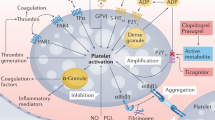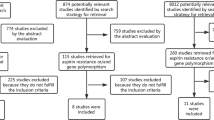Abstract
Cyclo-oxygenase (COX) 1 mediates the production of thromboxane A2 in platelets, leading to platelet aggregation and vasoconstriction. Conversely, COX2 catalyzes endothelial prostacyclin synthesis, which effectively counteracts thromboxane A2, triggering vasodilation and platelet inhibition. Selective COX2 inhibitors decrease prostacyclin production, potentially disrupting homeostasis and creating a prothrombotic state. The VIGOR study findings of increased cardiovascular risk with rofecoxib were subsequently confirmed by large meta-analyses, observational studies and recent APPROVe trial publication. The APC trial findings of increased cardiovascular risk with Celebrex® (celecoxib) conflict with those in the ADAPT trial, the upcoming PreSAP publication, a case-control study by Graham et al. and prior large clinical trials, meta-analyses and observational studies of this drug. Therefore, while an adverse class effect is a possibility for COX2 inhibitors, the published data are inconsistent. Baseline cardiovascular risk in patients might contribute significantly to these findings. In light of the negative Vioxx® (rofecoxib) publicity, however, COX2 inhibitors might forever remain underinvestigated. The relative selectivity of these compounds for COX2 is extremely variable, casting significant doubt on the class-effect hypothesis. Improved endothelial function has also been reported with celecoxib, leading to endothelium-dependent vasodilation, and associated decreases in C-reactive protein and LDL cholesterol. The addition of meloxicam to low-dose aspirin and heparin has improved clinical outcomes after acute coronary syndromes. These are the first studies suggesting improvement in endothelial function and reduction of inflammation with COX2 inhibition. Thus, more randomized controlled trials are needed to study the relative cardiovascular effects of different COX2 inhibitors, alone and in combination with aspirin.
This is a preview of subscription content, access via your institution
Access options
Subscribe to this journal
Receive 12 print issues and online access
$209.00 per year
only $17.42 per issue
Buy this article
- Purchase on Springer Link
- Instant access to full article PDF
Prices may be subject to local taxes which are calculated during checkout

Similar content being viewed by others
References
Sanmuganathan PS et al. (2001) Aspirin for primary prevention of coronary heart disease: safety and absolute benefit related to coronary risk derived from meta-analysis of randomised trials. Heart 85: 265–271
US Preventive Services Task Force (2002) Aspirin for the primary prevention of cardiovascular events: recommendations and rationale. Ann Intern Med 136: 157–160
Antiplatelet Trialists' Collaboration (1994) Collaborative overview of randomized trials of antiplatelet therapy I: Prevention of death, myocardial infarction, and stroke by prolonged antiplatelet therapy in various categories of patients. BMJ 308: 81–106
Ryan TJ et al. (1999) 1999 update: ACC/AHA guidelines for the management of patients with acute myocardial infarction: a report of the American College of Cardiology/American Heart Association Task Force on Practice Guidelines (Committee on Management of Acute Myocardial Infarction). J Am Coll Cardiol 34: 890–911
Brooks PM and Day RO (1991) Nonsteroidal anti-inflammatory drugs—differences and similarities. N Engl J Med 324: 1716–1725
Vane JR and Botting RM (1998) Mechanism of action of nonsteroidal anti-inflammatory drugs. Am J Med 104 (Suppl 3A): 2S–8S
Kam PC and See AU (2000) Cyclo-oxygenase isoenzymes: physiological and pharmacological role. Anaesthesia 55: 442–449
Whittle BJ et al. (1980) Selective inhibition of prostaglandin production in inflammatory exudates and gastric mucosa. Nature 284: 271–273
Cryer B and Feldman M (1998) Cyclooxygenase-1 and cyclooxygenase-2 selectivity of widely used nonsteroidal anti-inflammatory drugs. Am J Med 104: 413–421
Reilly IA and Fitzgerald GA (1987) Inhibition of thromboxane formation in vivo and ex vivo: Implications for therapy with platelet inhibitory drugs. Blood 69: 180–186
Patrono C et al. (1985) Clinical pharmacology of platelet cyclooxygenase inhibition. Circulation 72: 1177–1184
FitzGerald GA (2002) Cardiovascular pharmacology of nonselective nonsteroidal anti-inflammatory drugs and coxibs: clinical considerations. Am J Cardiol 89: 26D–32D
Catella-Lawson F and Crofford LJ (2001) Cyclooxygenase inhibition and thrombogenicity. Am J Med 110 (Suppl 3A): 28S–32S
Mukherjee D (2002) Selective cyclooxygenase-2 (COX-2) inhibitors and potential risk of cardiovascular events. Biochem Pharmacol 63: 817–821
Linton MF and Fazio S (2004) Cyclooxygenase-2 and inflammation in atherosclerosis. Curr Opin Pharmacol 4: 116–123
Weir MR et al. (2003) Selective COX-2 inhibition and cardiovascular effects: a review of the rofecoxib development program. Am Heart J 146: 591–604
Meagher EA et al. (2003) Balancing gastroprotection and cardioprotection with selective cyclo-oxygenase-2 inhibitors: clinical implications. Drug Saf 26: 913–924
McAdam BF et al. (1999) Systemic biosynthesis of prostacyclin by cyclooxygenase (COX)-2: the human pharmacology of a selective inhibitor of COX-2. Proc Natl Acad Sci U S A 96: 272–277
Yamamoto T et al. (2001) Effect of cyclooxygenase-2 inhibitor (celecoxib) on the infarcted heart in situ. Pharmacology 63: 28–33
Bing RJ and Lomnicka M (2002) Why do cyclo-oxygenase-2 inhibitors cause cardiovascular events? J Am Coll Cardiol 39: 521–522
Aw TJ et al. (2005) Meta-analysis of cyclooxygenase-2 inhibitors and their effects on blood pressure. Arch Intern Med 165: 490–496
Topper JN et al. (1996) Identification of vascular endothelial genes differentially responsive to fluid mechanical stimuli: Cyclooxygenase-2, manganese superoxide dismutase and endothelial cell nitric oxide synthase are selectively up-regulated by steady laminar shear stress. Proc Natl Acad Sci USA 93: 10417–10422
Shinmura K et al. (2000) Cyclooxygenase-2 mediates the cardioprotective effects of the late phase of ischemic preconditioning in conscious rabbits. Proc Natl Acad Sci USA 97: 10197–10202
Bolli R et al. (2002) Discovery of a new function of cyclooxygenase (COX)-2: Cox-2 is a cardioprotective protein that alleviates ischemia/reperfusion injury and mediates the late phase of preconditioning. Cardiovasc Res 55: 506–519
Hennan JK et al. (2001) Effects of selective cyclooxygenase-2 inhibition on vascular responses and thrombosis in canine coronary arteries. Circulation 104: 820–825
Dowd NP et al. (2001) Inhibition of cyclooxygenase-2 aggravates doxorubicin-mediated cardiac injury in vivo. J Clin Invest 108: 585–590
Cheng Y et al. (2002) Role of prostacyclin in the cardiovascular response to thromboxane A2. Science 296: 539–541
Bombardier C et al. (2000) Comparison of upper gastrointestinal toxicity of rofecoxib and naproxen in patients with rheumatoid arthritis. VIGOR Study Group. N Engl J Med 343: 1520–1528
Solomon DH et al. (2002) Nonsteroidal anti-inflammatory drug use and acute myocardial infarction. Arch Intern Med 162: 1099–1104
Watson DJ et al. (2002) Lower risk of thromboembolic cardiovascular events with naproxen among patients with rheumatoid arthritis. Arch Intern Med 162: 1105–1110
Rahme E et al. (2002) Association between naproxen use and protection against acute myocardial infarction. Arch Intern Med 162: 1111–1115
Ray WA et al. (2002) Non-steroidal anti-inflammatory drugs and risk of serious coronary heart disease: an observational cohort study. Lancet 359: 118–123
Graham DJ et al. (2005) Risk of acute myocardial infarction and sudden cardiac death in patients treated with cyclo-oxygenase 2 selective and non-selective non-steroidal anti-inflammatory drugs: nested case-control study. Lancet 365: 475–481
Silverstein FE et al. (2000) Gastrointestinal toxicity with celecoxib vs nonsteroidal anti-inflammatory drugs for osteoarthritis and rheumatoid arthritis. The CLASS study: a randomized controlled trial. Celecoxib Long-term Arthritis Safety Study. JAMA 284: 1247–1255
Catella-Lawson F et al. (2001) Cyclooxygenase inhibitors and the antiplatelet effects of aspirin. N Engl J Med 345: 1809–1817
Nussmeier NA et al. (2005) Complications of the COX-2 inhibitors parecoxib and valdecoxib after cardiac surgery. N Engl J Med 352: 1081–1091
Whelton A (online 7 March 2005) Safety of parecoxib and valdecoxib in the treatment of postoperative pain following coronary artery bypass graft surgery or major general surgery [http://www.acc05online.acc.org/highlights/keyLectures.aspx?sessionId=8030&date=7] (accessed 22 April 2005)
Matsumoto AK et al. (2002) A randomized controlled, clinical trial of etoricoxib in the treatment of rheumatoid arthritis. J Rheumatol 29: 1623–1630
Farkouh ME et al. (2004) Comparison of lumiracoxib with naproxen and ibuprofen in the Therapeutic Arthritis Research and Gastrointestinal Event Trial (TARGET), cardiovascular outcomes: randomised controlled trial. Lancet 364: 675–684
Mukherjee D et al. (2001) Risk of cardiovascular events associated with selective COX-2 inhibitors. JAMA 286: 954–959
Reicin AS et al. (2002) Comparison of cardiovascular thrombotic events in patients with osteoarthritis treated with rofecoxib versus nonselective nonsteroidal anti-inflamamtory drugs (ibuprofen, diclofenac, and nabumetone). Am J Cardiol 89: 204–209
Konstam MA et al. (2001) Cardiovascular thrombotic events in controlled clinical trials of rofecoxib. Circulation 104: 2280–2288
White WB et al. (2003) Cardiovascular thrombotic events in arthritis trials of the cyclooxygenase-2 inhibitor celecoxib. Am J Cardiol 92: 411–418
White WB et al. (2004) Effects of the cyclooxygenase-2 specific inhibitor valdecoxib versus nonsteroidal anti-inflammatory agents and placebo on cardiovascular thrombotic events in patients with arthritis. Am J Ther 11: 244–250
Mamdani M et al. (2003) Effect of selective cyclooxygenase-2 inhibitors and naproxen on short-term risk of acute myocardial infarction in the elderly. Arch Intern Med 163: 481–486
Solomon DH et al. (2004) Relationship between selective cyclooxygenase-2 inhibitors and acute myocardial infarction in older adults. Circulation 109: 2068–2073
Shaya FT et al. (2005) Selective cyclooxygenase-2 inhibition and cardiovascular effects: an observational study of a Medicaid population. Arch Intern Med 165: 181–186
Bresalier RS et al. (2005) Cardiovascular events associated with rofecoxib in a colorectal adenoma chemoprevention trial. Adenomatous Polyp Prevention on Vioxx (APPROVe) Trial Investigators. N Engl J Med 352: 1092–1102
Solomon SD et al. (2005) Cardiovascular risk associated with celecoxib in a clinical trial for colorectal adenoma prevention. Ademona Prevention with Celecoxib (APC) Study Investigators. N Engl J Med 352: 1071–1080
Levin B (Online 18 April 2005) The PreSAP Trial (Prevention of Colorectal Sporadic Adenomatous Polyps). [http://www.masterdocs.com/PDF/C7%20The%20PreSAP%20Trial%20(Prevention%20of%20Colorectal%20Sporadic%20Adenomatous%20Polyps)%20-%20Bernard%20Levin%20MD.pdf] (accessed 22 April 2005)
NIH Department of Health and Human Services, NIH News (online 20 December 2004) Use of non-steroidal anti-inflammatory drugs suspended in large Alzheimer's disease prevention trial [http://www.nih.gov/news/pr/dec2004/od-20.htm] (accessed 22 April 2005)
Konstam MA and Weir MR (2002) Current perspective on the cardiovascular effects of coxibs. Cleve Clin J Med 69 (Suppl 1): S147–S152
Altman R et al. (2002) Efficacy assessment of meloxicam, a preferential cyclooxygenase-2 inhibitor, in acute coronary syndromes without ST-segment elevation: the Nonsteroidal Anti-inflammatory Drugs in Unstable Angina Treatment-2 (NUT-2) pilot study. Circulation 106: 191–195
Chenevard R et al. (2003) Selective COX-2 inhibition improves endothelial function in coronary artery disease. Circulation 107: 405–409
Van Hecken A et al. (2000) Comparative inhibitory activity of rofecoxib, meloxicam, diclofenac, ibuprofen and naproxen on COX-2 versus COX-1 in healthy volunteers. J Clin Pharmacol 40: 1109–1120
Dalen JE (2002) Selective COX-2 inhibitors, NSAIDs, aspirin and myocardial infarction. Arch Intern Med 162: 1091–1092
Jenkins JK (online 6 April 2005) Memorandum: Analysis and recommendations for Agency action regarding non-steroidal anti-inflammatory drugs and cardiovascular risk. (accessed 22 April 2005)
Abramson SB et al. (2001) Controversies in COX-2 inhibitor therapy: closing remarks. Clin Exp Rheumatol 19 (Suppl 25): S77–S80
Author information
Authors and Affiliations
Corresponding author
Ethics declarations
Competing interests
The authors declare no competing financial interests.
Glossary
- ODDS RATIO (OR)
-
Ratio of odds of an event in intervention group to odds in control group; when <1 for an undesirable outcome, the intervention reduced the risk
Rights and permissions
About this article
Cite this article
Spektor, G., Fuster, V. Drug Insight: cyclo-oxygenase 2 inhibitors and cardiovascular risk—where are we now?. Nat Rev Cardiol 2, 290–300 (2005). https://doi.org/10.1038/ncpcardio0214
Received:
Accepted:
Issue Date:
DOI: https://doi.org/10.1038/ncpcardio0214
This article is cited by
-
Incretins and microvascular complications of diabetes: neuropathy, nephropathy, retinopathy and microangiopathy
Diabetologia (2023)
-
Role of ROS and COX-2/iNOS inhibition in cancer chemoprevention: a review
Phytochemistry Reviews (2012)
-
Effects of UVB on E Prostanoid Receptor Expression in Murine Skin
Journal of Investigative Dermatology (2007)
-
The Anti-Cancer Effect of COX-2 Inhibitors on Gastric Cancer Cells
Digestive Diseases and Sciences (2007)
-
Do cyclo-oxygenase 2 inhibitors increase the risk of cardiovascular events?
Nature Clinical Practice Oncology (2005)



